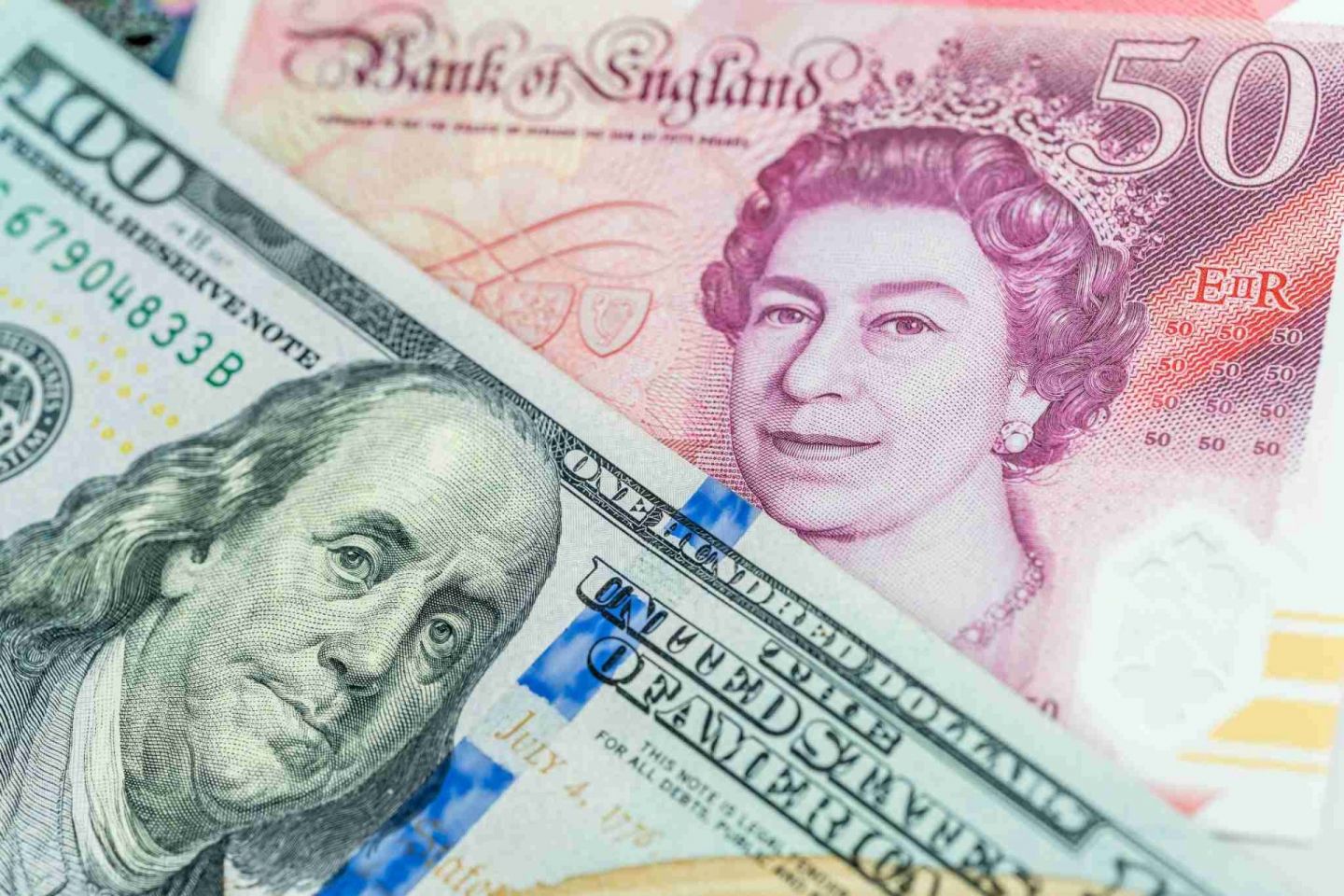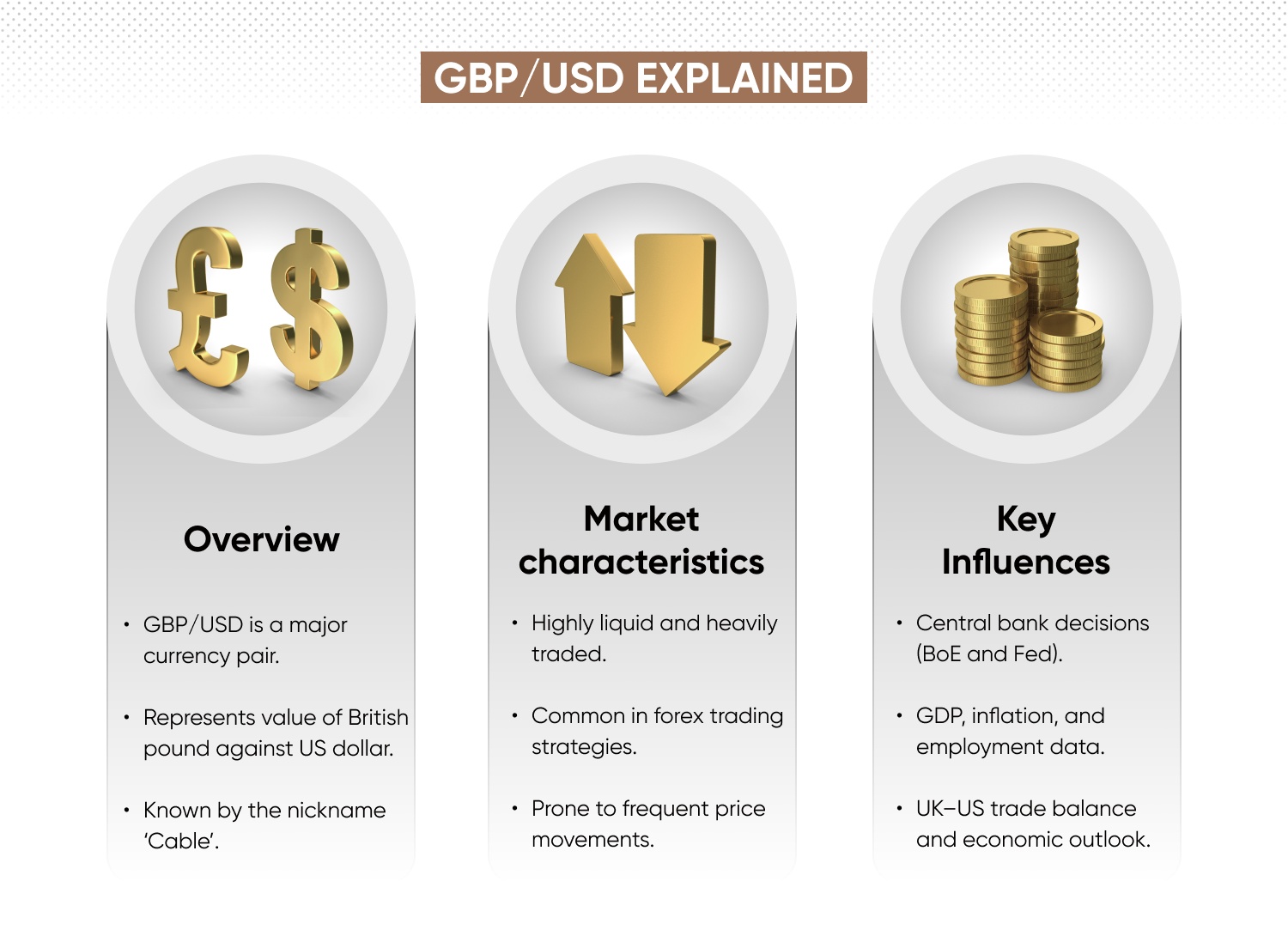What is GBP/USD (Pound-Dollar pair), and how do you trade it?

Learn about GBP/USD also known as 'Cable', including key price drivers, trading strategies, and how to trade GBP/USD via CFDs.
What is GBP/USD?
GBP/USD, commonly known as ‘Cable,’ is a major forex pair representing the exchange rate from GBP to USD (British pound to US dollar). GBP/USD ranks among the most actively traded pairs on the forex market, comprising currencies from two of the world’s largest economies – the United Kingdom and the US.
The nickname 'Cable' originates from the 19th-century transatlantic telegraph cables used to transmit exchange rates between London and New York, two leading global financial centres.
GBP/USD is recognised for its high liquidity, substantial trading volume, and frequent volatility. The pair often responds strongly to economic indicators, including interest-rate decisions from the Bank of England (BoE) and the US Federal Reserve (Fed), GDP growth data, inflation reports, and trade figures.

Learn more in our comprehensive trader’s guides:
Why trade GBP/USD?
GBP/USD offers distinct potential trading opportunities due to the following characteristics:
- Volume and liquidity: GBP/USD’s deep liquidity typically results in tight spreads, especially during peak trading hours, allowing efficient trade execution.
- Price volatility: the pair often sees significant price fluctuations around major economic events, such as interest rate announcements.
- Economic data correlation: GBP/USD reacts predictably to economic data from the UK and US, including inflation, employment figures, and GDP reports.
- Distinct technical behaviour: GBP/USD commonly exhibits clear chart patterns and identifiable support/resistance zones, aiding technical analysis strategies.
Past performance doesn't guarantee future results – GBP/USD's characteristics evolve with shifting macroeconomic, geopolitical, and country-specific conditions.
Potential risks of trading GBP/USD in forex
While GBP/USD presents substantial trading opportunities, traders should be mindful of specific risks associated with this currency pair.
- High volatility: GBP/USD experiences sharp price swings around economic events, potentially magnifying losses if not managed properly.
- Currency correlation risk: movements in GBP/USD can be influenced by global sentiment or shifts in related currency pairs, such as EUR/USD or USD/JPY.
- Liquidity-driven price gaps: holding positions overnight or during weekends can expose traders to unexpected gaps, leading to losses exceeding initial expectations.
Traders could use trading strategies for a structured approach, and risk management tools such as stop-loss and take-profit to help mitigate potential downside risks.
What influences the GBP/USD rate?
GBP/USD’s price fluctuates constantly, influenced by factors directly impacting the forex rate (USD to GBP) and dollar-to-pounds exchange – such as economic data releases, monetary policy, and global market sentiment.
Interest rate decisions (BoE and Fed)
Interest rates set by the Bank of England (BoE) and the U.S. Federal Reserve (Fed) may directly influence GBP/USD’s price. Changes in relative interest rates between the two central banks typically affect demand – higher rates tend to attract investors seeking better returns. For example, if the Fed raises interest rates while the BoE holds steady, GBP/USD could fall as demand for USD increases. Conversely, if the BoE signals rate hikes ahead of the Fed, GBP/USD might strengthen.
Economic indicators impacting GBP/USD
Economic data releases such as UK and US CPI (inflation), GDP growth, and employment statistics influence GBP/USD price volatility. Stronger-than-expected UK economic data, like robust GDP growth or falling unemployment, may drive GBP/USD higher. Conversely, if US inflation rises sharply and boosts expectations of Fed tightening, the US dollar could appreciate, pushing GBP/USD lower. Monitor these releases on our in-app economic calendar for key indicators, news and updates on upcoming events.
Political developments and events
Political events and policy decisions can cause volatility in GBP/USD. Brexit-related developments have historically influenced sterling – positive UK-specific outcomes tend to support GBP/USD, while uncertainty often weighs on it. Similarly, political developments like US fiscal policy changes or government shutdowns can affect USD strength, potentially influencing GBP/USD price movements.
Risk sentiment and global trends
Global investor risk appetite significantly affects GBP/USD. In times of economic optimism, investors may favour growth-sensitive major currencies like GBP, potentially boosting GBP/USD. However, during periods of uncertainty or market turmoil, investors could favour safe-haven currencies like USD, possibly causing GBP/USD to decline. For example, during the early stages of the COVID-19 pandemic, the USD strengthened sharply as investors sought safety.
Discover forex market price drivers & more on our market analysis page.

Discover more forex market characteristics in our comprehensive forex trading guide.
How to trade GBP/USD CFDs with us
Getting started with GBP/USD contracts for difference (CFDs) on our platform is intuitive and you can be trading in minutes once your account is approved. Simply follow these practical steps to open your first GBP/USD position:
- Create a trading account and complete the verification process.
- Choose ‘GBP/USD’ from our CFD instrument list.
- Set trade parameters, including trade size, leverage, and risk management tools.
- Practise with a demo account, to test your trading strategy with virtual funds.
- Place your trade, based on your chosen trading strategy, once you’re ready to trade.
- Buy or sell? Select ‘buy’ anticipating GBP/USD to rise, or ‘sell’ expecting it to fall.
- Monitor your position, use our advanced charting tools and real-time analytics to stay informed and manage your trades effectively.
Our user-friendly web platform and mobile app provide intuitive features for CFD traders, including technical and fundamental indicators, market analysis, customisable alerts, robust risk management tools, and dedicated 24/7 support.
Ready to start trading GBP/USD? Try a demo account to experience our platform first-hand.
What are some top GBP/USD trading strategies?
GBP/USD trading strategies can provide a structured approach. Knowing when to trade GBP USD enhances strategy effectiveness and aligns trades with periods of optimal market volatility. Traders might also use tools like a forex pip calculator to measure price movements.
- Trend trading: involves identifying GBP/USD’s price direction using technical indicators. Trend traders might open long positions when the pair forms higher highs and higher lows, or short positions during sustained downward momentum.
- Breakout trading: focuses on sharp price movements following the breakout of key support or resistance levels. Breakout traders might set entry orders just outside these levels to capture rapid directional moves.
- Range trading: particularly useful during lower-volatility periods, such as between major data releases. Range traders aim to buy near identified support levels and sell near resistance.
- Macro trading: a strategy with a medium-term outlook – often spanning weeks to months – attempting to capture gains when UK and US economic outlooks diverge.
Explore more about shares trading in our shares trading guide and on our trading strategies page.
What are GBP/USD’s forex trading hours & market overlaps?
GBP/USD trades 24 hours a day, five days a week, in line with global forex market hours.
Trading activity varies depending on market sessions, historically increasing during the overlap of the London and New York markets, where liquidity and volatility peak – from 1pm to 5pm UTC in winter, and 12pm to 4pm UTC in summer.*
Major trading sessions for GBP/USD forex pair:
| Session | Summer (UTC) | Winter (UTC) |
| London | 7am to 4pm | 8am to 5pm |
| New York | 12pm to 9pm | 1pm to 10pm |
GBP/USD is most actively traded when economic data releases – such as UK employment figures or US non-farm payrolls – coincide with these session overlaps, offering optimal conditions for volatility-based trading strategies.
For detailed, up-to-date forex trading hours, visit our dedicated forex trading hours page.
*Peak trading hours are based on historical trends, and are subject to change due to evolving market conditions and specific events.
FAQs
Is GBP/USD good for beginners?
GBP/USD can be suitable for newer traders who have a foundational understanding of forex trading, as its high liquidity often results in consistent pricing and competitive spreads. However, the pair can experience sharp volatility around UK and US economic data or political events. Beginners should trade cautiously, focusing on defined strategies, technical setups, and robust risk management.
What is the best time of day to trade GBP/USD?
Optimal trading hours for GBP/USD historically occur when London and New York sessions overlap – from 1pm to 5pm UTC in winter, and 12pm to 4pm in summer. This window typically provides increased liquidity, tighter spreads, and heightened volatility, ideal for day traders or those using short-term strategies – however trading activity can also be influenced by evolving market conditions and country-specific events.
What is the average spread on GBP/USD?
GBP/USD CFD spreads can vary depending on market conditions, broker pricing models, and trading volumes. During active trading hours, spreads might be tighter, while periods of low liquidity or high volatility – such as around major news events – can lead to a temporary widening. Traders should review live pricing and remain aware of changing spread dynamics.
How is GBP/USD affected by interest rate decisions?
GBP/USD frequently reacts sharply to interest rate decisions and monetary policy statements from the Bank of England (BoE) and the Federal Reserve (Fed). Rate hikes or hawkish guidance from the BoE historically to strengthen the GBP, while dovish signals can weigh on it. Likewise, hawkish moves from the Fed can support USD strength. Traders monitor central bank announcements, minutes, and forward guidance closely to anticipate and respond to market movements.